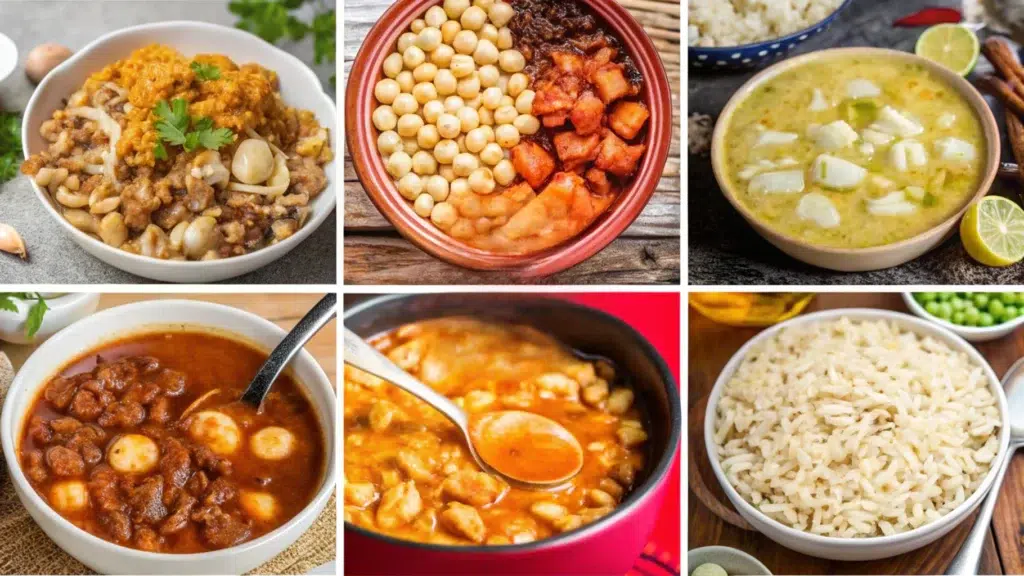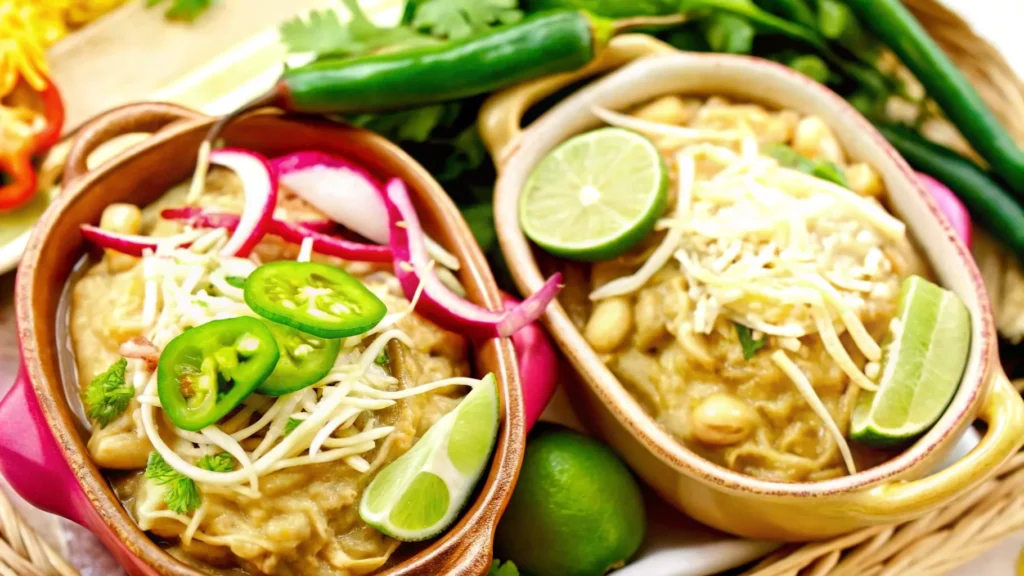What’s in a name? Regarding posole and pozole, there’s quite a bit to uncover! These two terms might sound almost identical, but their subtle differences open the door to rich cultural history, culinary traditions, and even a little linguistic intrigue. This article dives into the origins, ingredients, and unique nuances of these beloved dishes while answering the question: What is the difference between posole and pozole?
From exploring their historical roots to breaking down the distinct ways they’re served, we’ll examine why these dishes hold such a cherished spot in Mexican gastronomy. Let’s get started with an introduction to these iconic dishes.
Introduction to Posole and Pozole
What Are Posole and Pozole?
Posole and pozole both refer to a hearty, flavorful soup or stew originating in Mexican cuisine. They feature hominy (nixtamalized corn) as their central ingredient. The terms are often used interchangeably but reflect subtle differences shaped by culture and geography. While pozole is more commonly associated with traditional Mexican roots, posole tends to appear in U.S. adaptations of the dish, influenced by regional dialects and preferences.
This dish celebrates hominy, slow-cooked with savory broth, meat (often pork or chicken), and an array of spices. Garnishes like shredded lettuce, radishes, and lime elevate its flavor profile, creating a dish that’s as visually stunning as delicious.
Why Is This Comparison Important?
The distinction between posole and pozole goes beyond spelling. It represents how culinary traditions travel, adapt, and evolve across borders. Understanding these nuances not only clears up common misconceptions but also deepens our appreciation for Mexico’s vibrant culinary heritage. Whether you’re savoring a bowl labeled as “posole” or “pozole,” you’re partaking in a dish that embodies centuries of history and cultural significance.
Origins and Historical Background

The Roots of Pozole in Mexican Culture
Pozole’s story begins centuries ago, deeply rooted in ancient Mexican traditions. This iconic dish dates back to the Aztec civilization, where it was prepared for special rituals and celebrations. The word pozole itself comes from the Nahuatl word pozolli, meaning “foamy” or “frothy,” a nod to the texture of cooked hominy. For the Aztecs, the dish symbolized unity and abundance, often served during communal events or religious ceremonies.
Interestingly, the original recipe featured human meat in place of pork—a reflection of its ritualistic ties. After the Spanish conquest, the recipe evolved to incorporate pork, which was introduced to the region and considered a close substitute. This adaptation gave us the pozole we know and love today.
Regional Variations and Naming Differences
Over time, as Mexican cuisine spread beyond its borders, the dish’s name began to change. In Mexico, pozole remained the preferred term, staying true to its indigenous roots. However, in the United States, the dish is often referred to as posole. This shift can be attributed to linguistic adaptations and regional influences, especially in areas with strong Tex-Mex traditions.
So, what is the difference between posole and pozole? At its core, the answer lies in the interplay of culture and geography. While the names differ, they reflect the same delicious dish, showcasing the power of food to bridge cultural divides.
Key Ingredients and Preparation Methods
Core Ingredients Shared by Both
At the heart of both posole and pozole is one essential ingredient: hominy. This nixtamalized corn is the soul of the dish, providing a chewy, satisfying texture and a subtle, earthy flavor. Beyond that, the base typically includes a rich, savory broth, usually made with pork or chicken, and a blend of spices like garlic, oregano, and cumin.
Garnishes play a big role in elevating the dish. Whether it’s shredded lettuce, sliced radishes, avocado, or a squeeze of lime, these toppings add freshness and crunch to every bite. Both versions also allow for a range of accompaniments, like warm tortillas or crispy tostadas.
Notable Differences in Ingredients
The key differences between posole and pozole often come down to regional preferences. While traditional pozole recipes might use dried chiles like guajillo or ancho for a smoky, spicy kick, posole adaptations in the U.S. sometimes substitute these with more accessible seasonings or canned ingredients. Additionally, posole verde (green posole) and pozole rojo (red pozole) highlight regional variations in flavor profiles, with tomatillos or red chiles as the defining ingredients.
Traditional vs. Modern Cooking Techniques
Historically, both posole and pozole were slow-cooked over hours, allowing the flavors to meld beautifully. Today, however, modern tools like Instant Pots and slow cookers have made the process faster and more convenient. Despite these updates, the essence of the dish remains unchanged—a hearty, comforting meal that brings people together.
By understanding these ingredients and techniques, we get closer to answering what is the difference between posole and pozole, as well as appreciating the adaptability of this beloved dish.
The Role of Hominy in Posole and Pozole

What Is Hominy?
Hominy is the backbone of both posole and pozole. This unique ingredient is made from dried corn kernels that have undergone nixtamalization, which involves soaking the kernels in an alkaline solution to remove the hull. This method, dating back to ancient Mesoamerican civilizations, not only enhances the flavor and texture of the corn but also increases its nutritional value.
Nixtamalized corn, or hominy, gives these dishes their signature chewy texture and hearty character. Without hominy, neither posole nor pozole would have the same depth of flavor or cultural significance.
Why Hominy Defines the Dish
The unique texture and subtle taste of hominy makes it indispensable in posole and pozole. Whether paired with spicy chiles in pozole rojo or bright tomatillos in posole verde, hominy provides a base that balances the bold flavors of the broth and garnishes. Its versatility allows it to shine in traditional recipes and modern adaptations.
If you’re curious about how other traditional Mexican recipes use corn as a staple ingredient, check out this pozole history and recipe guide for more inspiration.
Regional and Linguistic Influences
The Spanish Language Factor
One key element in answering the difference between posole and pozole lies in the Spanish language. Pozole is the correct spelling in Mexico, staying true to its Nahuatl origins and centuries of culinary history. Meanwhile, the term posole is more commonly used in the United States, influenced by regional dialects and adaptations.
The difference in spelling doesn’t affect the dish’s preparation or taste but reflects how language evolves as it crosses borders. This shift is a fascinating example of how food adapts to new cultures while retaining its essence.
Culinary Adaptations in the U.S.
When Mexican immigrants brought pozole to the United States, the dish changed slightly to suit local tastes and ingredient availability. Regional influences, especially in Tex-Mex cuisine, introduced variations like canned hominy and different spice blends, creating posole. This adaptation made the dish more accessible to American home cooks while still celebrating its Mexican roots.
Whether posole or pozole, the dish remains a comforting and flavorful representation of Mexican culinary heritage. Check out this guide to authentic frijoles Quercus for more traditional Mexican recipes.
Serving and Presentation Differences
Traditional Garnishes and Additions
Regarding posole and pozole, presentation matters almost as much as flavor. Both dishes are traditionally topped with fresh garnishes that add color, texture, and balance. Classic toppings include shredded lettuce or cabbage, thinly sliced radishes, diced onions, avocado slices, and a squeeze of fresh lime. These garnishes not only brighten the dish but also allow diners to customize each bowl to their liking.
Another staple served alongside is warm corn tortillas or crispy tostadas. These accompaniments are perfect for scooping up the savory broth and tender chunks of meat. The combination of garnishes and sides creates a dining experience that’s both flavorful and interactive, much like assembling a cookie cake with personalized toppings.
Plating and Dining Styles
Though the ingredients and garnishes are similar, the consistency of posole and pozole can vary. In some regions, pozole is served with a thinner, soup-like broth, while posole often has a heartier, stew-like consistency. These differences reflect regional preferences but don’t alter the dish’s essence.
Both versions are commonly enjoyed in large gatherings or festive celebrations, making them a centerpiece for communal meals. Whether served at a casual family dinner or a grand holiday feast, these dishes offer warmth and comfort to all who partake.
FAQs on Posole and Pozole
What Is the Traditional Pozole Recipe?
A traditional pozole recipe starts with hominy, slow-cooked with pork or chicken in a flavorful broth. The broth is seasoned with garlic, onion, and a variety of chiles, such as guajillo or ancho, which give it a smoky depth. Tomatillos and fresh herbs are used instead of red chiles for green pozole. The final touch involves topping the dish with a vibrant mix of garnishes.
Is There a Health Difference Between the Two?
Both posole and pozole are hearty, nutritious meals, but their health depends on the recipe. Traditional recipes with fresh ingredients are rich in protein, fiber, and essential vitamins. Modern adaptations may include additional fats or processed ingredients, which can alter their nutritional profile. Some recipes swap pork for chicken or vegetarian options for a healthier twist.
Can You Use Posole and Pozole Interchangeably?
Yes, you can! Despite the spelling difference, posole and pozole are essentially the same dish. The variation in terminology is more about regional preferences than culinary distinction. The process and ingredients remain broadly consistent whether you’re making a green pozole or a red posole.
By understanding these FAQs, the difference between posole and pozole becomes much clearer. The dishes’ similarities far outweigh their differences, making either version a delicious addition to your recipe repertoire. And just like customizing a cookie cake to suit your taste, you can tweak these recipes to create your perfect bowl.
Conclusion and Final Thoughts
Why Understanding This Difference Matters
What is the difference between posole and pozole? At first glance, it seems like a small detail, but understanding this difference opens the door to exploring cultural, linguistic, and culinary traditions. These dishes reflect the vibrant heritage of Mexican cuisine, showcasing how food evolves across regions and borders.
A Celebration of Cultural and Culinary Diversity
Whether posole or pozole, this dish represents more than just a meal. It’s a story of history, adaptation, and togetherness. By savoring every bite, we honor the traditions and creativity that make this dish so beloved worldwide.
Frequently Asked Questions
How to Do Posole and Pozole Differ in Spelling?
The spelling difference between posole and pozole reflects regional language variations. In Mexico, pozole adheres to the original Spanish and Nahuatl roots, while in the United States, posole emerged as a more common spelling due to regional dialects and adaptations.
Are There Vegetarian Versions of These Dishes?
Absolutely! While traditional recipes feature pork or chicken, vegetarian options are increasingly popular. These versions often use vegetable broth and incorporate hearty ingredients like beans, squash, and mushrooms to replicate the dish’s rich, satisfying texture.
Is Posole or Pozole a Seasonal Dish?
Both are often enjoyed year-round, but their hearty, warming qualities make them especially popular during colder and festive occasions. Pozole is a staple in celebrations like Mexican Independence Day and Christmas in Mexico.
Final Thoughts on the Difference
The question of what the difference between posole and pozole is highlights how even small linguistic changes can represent broader cultural and culinary nuances. No matter how it’s spelled, this dish remains a testament to the beauty of shared traditions and flavors.
This concludes our in-depth exploration of posole and pozole, celebrating their rich heritage and enduring appeal. Whether you’re preparing a family recipe or trying it for the first time, remember that every bowl carries centuries of history and love.

